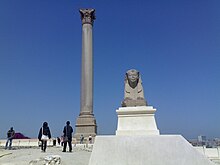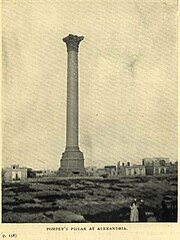Pompey's Pillar (column)
 Pompey's Pillar | |
 Shown within Egypt | |
| Location | Alexandria, Egypt |
|---|---|
| Coordinates | 31°10′56.98″N 29°53′47.23″E / 31.1824944°N 29.8964528°ECoordinates: 31°10′56.98″N 29°53′47.23″E / 31.1824944°N 29.8964528°E |
| Type | Roman triumphal column |
| Diameter | c. 2.7-2.8 m (column shaft) |
| Height | c. 33.85 m (total original with 7 m statue)
26.85 m (present total) 20.75 m (monolithic granite column shaft) 6 m (granite socle) |
| History | |
| Builder | Publius praefectus aegypti on behalf of emperor Diocletian |
| Material | granite, lost statue in porphyry |
| Founded | 298-303 AD (dedicated) |


Pompey's Pillar (Arabic: عمود السواري) is the name given to a Roman triumphal column in Alexandria, Egypt. Set up in honour of the augustus Diocletian between 298-302 AD, the giant Corinthian column originally supported a colossal porphyry statue of the emperor in armour.[1] It stands at the eastern side of the temenos of the Serapeum of Alexandria, beside the ruins of the temple of Serapis itself. The erroneous name and association with Pompey stems from historical misreading of the Greek dedicatory inscription on the base.[2]
Construction[]
In 297 Diocletian, augustus since 284, campaigned in Egypt to suppress the revolt of the usurper Domitius Domitianus. After a long siege, Diocletian captured Alexandria and executed Domitianus's successor Aurelius Achilleus in 298. In 302 the emperor returned to the city and inaugurated a state grain supply.[2] The dedication of the column monument and its statue of Diocletian, describes Diocletian as polioúchos (Ancient Greek: πολιοῦχον Ἀλεξανδρείας, romanized: polioúchon Alexandreias, lit. 'city-guardian-god ACC of Alexandria').[3][4] In the fourth century AD this designation also applied to Serapis, the male counterpart of Isis in the pantheon instituted by the Hellenistic rulers of Egypt, the Ptolemies.[5][6] The sanctuary complex dedicated to Serapis in which the column was originally erected, the Serapeum, was built under King Ptolemy III Euergetes in the third century BC and probably rebuilt in the era of the second century AD emperor Hadrian after sustaining damage in the Kitos Wars; in the later fourth century AD it was considered by Ammianus Marcellinus a marvel rivalled only by Rome's sanctuary to Jupiter Optimus Maximus on the Capitoline Hill, the Capitolium.[7]
The column was the largest of its type constructed outside the imperial capitals of Rome and Constantinople.[8] The monument stands some 26.85 m (almost 90 ft) high, and originally would have supported a statue some 7 m (23 ft) tall.[2][9][1] The only known free-standing column in Roman Egypt which was not composed of drums,[8] it is one of the largest ancient monoliths and one of the largest monolithic columns ever erected. The monolithic column shaft measures 20.46 m in height with a diameter of 2.71 m at its base, the socle itself is over 6 m tall.[10][2] The column and socle are of lapis syenites, a pink granite cut from the ancient quarries at Syene (modern Aswan), while the column capital of pseudo-Corinthian type is of grey granite.[2] The weight of the column shaft, a single piece of red granite, is estimated to be 285 tonnes.[10] The column is 26.85 m high including its base and capital.[10] Other authors give slightly deviating dimensions.[a]
The surviving and readable four lines[4] of the inscription in Greek on the column's socle relate that a Praefectus Aegypti (Ancient Greek: ἔπαρχος Αἰγύπτου, romanized: eparchos Aigyptou, lit. 'Eparch of Egypt') called Publius dedicated the monument in Diocletian's honour.[12] The monument commemorated the victories of the augustus on one of his visits to Egypt, commemorating either the institution of the Alexandrian state grain supply, or the victory over Domitius Domitianus.[2][10] A praefectus aegypti named Publius is attested in two papyri from Oxyrrhynchus; his governorship must have been held in between the prefectures of , who is named as governor on 16 March 297, and Clodius Culcianus, in office from 303 or even late 302.[12] Since Publius's name appears as the monument's dedicator, the column and stylite statue of Diocletian must have been completed between 297 and 303, while he was in post. The governor's name is largely erased in the damaged inscription; the remaining rendering of Publius as ΠΟΥΠΛΙΟΣ (Πού̣π̣[λιος], Pouplios)[13] was confused with the Greek spelling of the Republican general of the first century BC Pompey, ΠΟΜΠΗΙΟΣ (Ancient Greek: Πομπήιος, romanized: Pompeios, Latin: Pompeius).[2]
The porphyry statue of Diocletian in armour is known from large fragments that existed at the column's foot in the eighteenth century AD. From the size of a 1.6 m fragment representing the thighs of the honorand, the original size of the loricate statue has been calculated at approximately 7 m tall.[1] While some fragments of the statue were known to be in European collections in the nineteenth century, their whereabouts were unknown by the 1930s and are presumed lost.[1][9]
It is possible that the large column supporting Diocletian's statue was accompanied by another column, or three smaller columns bearing statues of Diocletian's co-emperors, the augustus Maximian and the two caesares Constantius and Galerius. If so, the group of column-statues would have commemorated the college of emperors of the Tetrarchy instituted in Diocletian's reign.[8]
Ascents[]
Muslim traveller Ibn Battuta visited Alexandria in 1326 AD. He describes the pillar and recounts the tale of an archer who shot an arrow tied to a string over the column. This enabled him to pull a rope tied to the string over the pillar and secure it on the other side in order to climb over to the top of the pillar.[14]

In early 1803, British naval officer Commander John Shortland of HMS Pandour flew a kite over Pompey's Pillar. This enabled him to get ropes over it, and then a rope ladder. On February 2, he and John White, Pandour's Master, climbed it. When they got to the top they displayed the Union Jack, drank a toast to King George III, and gave three cheers. Four days later they climbed the pillar again, erected a staff, fixed a weather vane, ate a beef steak, and again toasted the king.[15] An etymology of the nickname "Pompey" for the Royal Navy's home port of Portsmouth and its football team suggests these sailors became known as "Pompey's boys" after scaling the Pillar, and the moniker spread; other unrelated origins are also possible.[16]
See also[]
- List of ancient architectural records
- Browne-Clayton Monument
- Pompey's Pillar (disambiguation), listing other things named for this pillar
Notes[]
References[]
- ^ Jump up to: a b c d Delbrück 2007, pp. 100–101.
- ^ Jump up to: a b c d e f g Gehn, Ulrich (2012). "LSA-874: Column used as base for statue of Diocletian, emperor (so-called 'Column of Pompey'). Alexandria (Aegyptus). 297-302". Last Statues of Antiquity. University of Oxford. Retrieved 2020-03-06.
- ^ Kayser 1994, pp. 52–57, № 15.
- ^ Jump up to: a b Dittenberger, Wilhelm, "718", Orientis Graeci inscriptiones selectae (OGIS). At Searchable Greek Inscriptions of the Packard Humanities Institute.
- ^ Julian (1923). "Epistle 47: to the Alexandrians". Letters. Epigrams. Against the Galilaeans. Fragments. Loeb Classical Library 157. Translated by Wright, Wilmer C. Cambridge, MA: Harvard University Press. pp. 144–145–432-D. doi:10.4159/DLCL.emperor_julian-letters.1923. ISBN 9781258090814.
- ^ Rokeah, D. (1982-06-01). Jews, Pagans and Christians in Conflict. BRILL. ISBN 978-90-04-07025-7.
- ^ Ammianus Marcellinus, Res Gestae, XII:16:12. (1940). History, Volume II: Books 20-26. Loeb Classical Library 315. Translated by Rolfe, J. C. Cambridge, MA: Harvard University Press. pp. 300–303. doi:10.4159/DLCL.amminanus_marcellinus-history.1950.
His accedunt altis sufflata fastigiis templa, inter quae eminet Serapeum, quod licet minuatur exilitate verborum, atriis tamen columnatis amplissimus, et spirantibus signorum figmentis, et reliqua operum multitudine ita est exornatum, ut post Capitolium, quo se venerabilis Roma in aeternum attollit, nihil orbis terrarum ambitiosius cernat.
CS1 maint: multiple names: authors list (link)
[There are besides in the city temples pompous with lofty roofs, conspicuous among them the Serapeum, which, though feeble words merely belittle it, yet is so adorned with extensive columned halls, with almost breathing statues, and a great number of other works of art, that next to the Capitolium, with which revered Rome elevates herself to eternity, the whole world beholds nothing more magnificent.] - ^ Jump up to: a b c Thiel 2006, pp. 251–254.
- ^ Jump up to: a b Bergmann, Marianne (2012). "LSA-1005: Fragments of colossal porphyry statue of Diocletian in cuirass (lost ). From Alexandria. 297-302". Last Statues of Antiquity. University of Oxford. Retrieved 2020-03-06.
- ^ Jump up to: a b c d Adam 1977, pp. 50f.
- ^ Thiel 2006, pp. 252f.
- ^ Jump up to: a b Vandersleyen 1958, p. 114.
- ^ See Leiden Conventions.
- ^ "Ibn Battuta's Rihla". 1904 – via World Digital Library.
– Battutah, Ibn (2002). The Travels of Ibn Battutah. London: Picador. p. 7. ISBN 9780330418799. - ^ Naval Chronicle, Vol. 27, p. 111.
- ^ Dent, Susie, ed. (2012). Pompey. Brewer's Dictionary of Phrase & Fable. Chambers Harrap Publishers. Retrieved 2020-03-06.
Sources[]
- Adam, Jean-Pierre (1977). "À propos du trilithon de Baalbek: Le transport et la mise en oeuvre des megaliths". Syria. 54 (1–2): 31–63. doi:10.3406/syria.1977.6623. JSTOR 4198097.
- Delbrück, Richard (2007) [1932]. Antike Porphyrwerke. Berlin [reprinted: Rome]: de Guyter [reprinted L'Erma di Bretschneider]. ISBN 978-88-8265-454-2. OCLC 191032377.
- Kayser, F. (1994). Recueil des Inscriptions grecques et latines (non funéraires) d'Alexandrie impériale (in French). Cairo: Institut français d'archéologie orientale du Caire. ISBN 9782724701456.
- Thiel, W. (2006). "Die 'Pompeius-Säule' in Alexandria und die Vier-Säulen-Monumente Ägyptens". In Boschung, D.; Eck, W. (eds.). Die Tetrarchie: Ein neues Regierungssystem und seine mediale Repräsentation. Schriften des Lehr- und Forschungszentrums für die antiken Kulturen des Mittelmeerraumes. Wiesbaden: Reichert Verlag. pp. 251–270. ISBN 978-3895005107.
- Vandersleyen, C. (1958). Le préfet d'Égypte de la colonne de Pompée à Alexandrie. Chronique d’Égypte. 33. Brussels. pp. 113–134.
| Wikimedia Commons has media related to Pompey's Pillar. |
- Buildings and structures completed in the 3rd century
- Buildings and structures in Alexandria
- Roman victory columns
- Corinthian columns
- Monoliths
